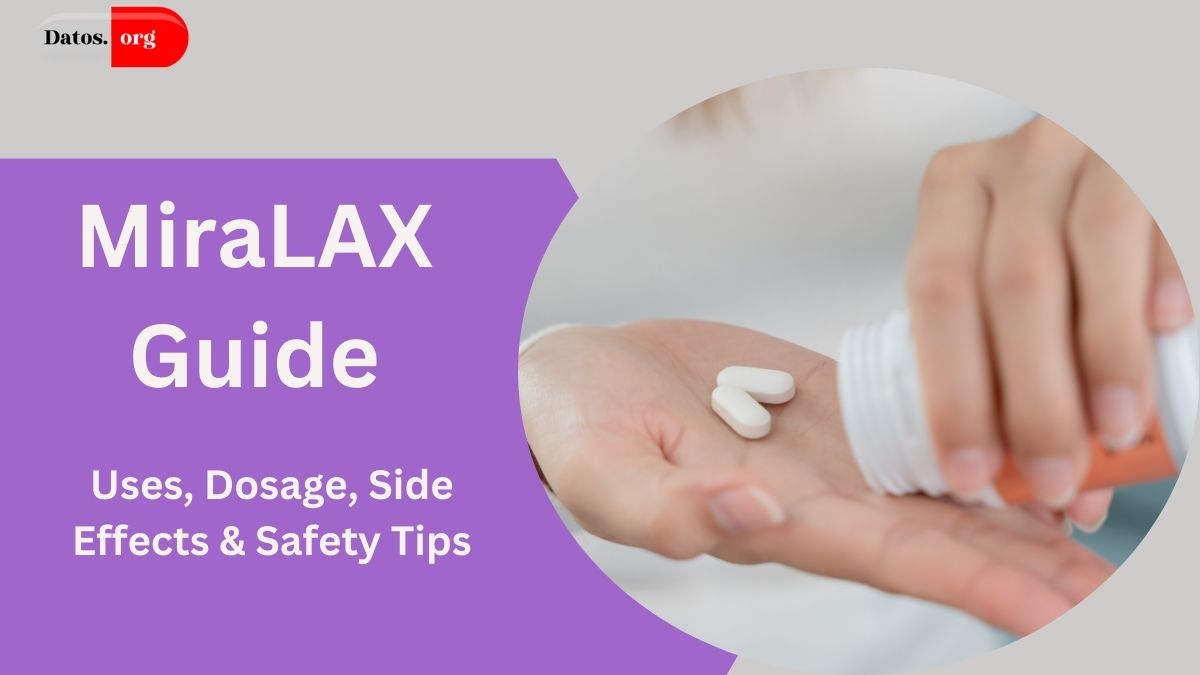MiraLAX (Polyethylene Glycol 3350) is a widely used over-the-counter laxative primarily designed to alleviate occasional constipation. It functions by drawing water into the colon, which helps to soften the stool and promote bowel movements.
MiraLAX is often preferred for its gentle action and ease of use, making it a go-to choice for those seeking relief from constipation. This guide explores its uses, dosage, side effects, and important safety information to provide a complete understanding of the medication.
- How MiraLAX Works
- Dosage and Administration
- Frequency of Use
- Onset of Action
- Safety and Precautions
- Potential Side Effects
- Drug Interactions
- Storage Instructions
- Frequently Asked Questions
- Can MiraLAX be taken every day?
- What should I do if I miss a dose?
- What should I avoid while taking MiraLAX?
- Is MiraLAX safe during pregnancy?
- Conclusion
How MiraLAX Works
MiraLAX is classified as an osmotic laxative. It contains Polyethylene Glycol 3350, which retains water in the stool, making it softer and easier to pass.
This action increases the water content in the bowel, facilitating natural movement through the digestive tract without causing sudden urgency or cramping. Unlike stimulant laxatives, MiraLAX works gradually, making it a gentle option for managing constipation.
Also Read: Difference Between Miralax Vs Metamucil
Dosage and Administration
MiraLAX is available in powder form, which must be dissolved in liquid before use. For adults and children aged 17 years and older, the standard dose is 17 grams of powder mixed into 4 to 8 ounces of a beverage, such as water, juice, soda, coffee, or tea.
The mixture should be stirred well and consumed immediately without storing it for later use. Ensuring that the powder is fully dissolved helps prevent clumping and ensures effectiveness.
For children under 17 years, a healthcare provider should be consulted to determine the appropriate dosage and duration. Pediatric dosing varies by age and weight, and specific guidelines must be followed.
Frequency of Use
MiraLAX is generally used once daily and should not be used for more than seven consecutive days unless advised by a healthcare provider. If constipation persists beyond a week of use, it is essential to seek medical advice, as this may indicate an underlying condition that requires different management.
Onset of Action
MiraLAX typically produces a bowel movement within 1 to 3 days of starting treatment. Because it works by drawing water into the colon, the relief it provides is gradual and gentle, reducing the likelihood of sudden or severe effects.
This slow onset is one of the reasons MiraLAX is favored for its mild approach to alleviating constipation without causing significant discomfort.
Safety and Precautions
MiraLAX is generally safe for most users, but it is important to consider some precautions:
- Allergies: Individuals with allergies to polyethylene glycol or other ingredients should avoid MiraLAX. Symptoms of an allergic reaction include skin rash, itching, and swelling of the face or throat.
- Underlying Conditions: Those with gastrointestinal issues such as bowel obstructions, perforations, or severe inflammation should not use MiraLAX without medical supervision.
- Use in Children: While MiraLAX can be used in children, dosing must be specifically adjusted according to age and weight, and pediatric use should always be guided by a healthcare professional.
Potential Side Effects
Common side effects of MiraLAX include bloating, gas, and an upset stomach. Some users may also experience dizziness or increased sweating.
Serious side effects, though rare, can include severe diarrhea, rectal bleeding, blood in stools, or intense abdominal pain. Should any of these severe symptoms occur, discontinue use immediately and consult a healthcare provider.
Drug Interactions
MiraLAX generally does not have significant interactions with most medications, making it a versatile option for many patients. However, it is always advisable to inform healthcare providers about all medications, supplements, and herbal products being used to ensure no potential interactions.
Additionally, lifestyle factors such as alcohol consumption and diet should be discussed with a healthcare provider, as these can influence the effectiveness of MiraLAX.
Storage Instructions
MiraLAX should be stored at room temperature, away from moisture and heat, to preserve its effectiveness. It is important to keep the medication out of reach of children and pets.
Unused or expired MiraLAX should be disposed of properly. Ideally, it should be taken to a medication take-back program, or if unavailable, disposed of following guidance from a pharmacist or the product’s packaging.
Frequently Asked Questions
Can MiraLAX be taken every day?
MiraLAX can be taken daily for up to one week. If symptoms persist, consult a healthcare provider for further guidance. Prolonged use without supervision can lead to dependence or mask serious conditions.
What should I do if I miss a dose?
If you miss a dose, take it as soon as you remember. If it is almost time for the next dose, skip the missed one and continue as usual. Do not double doses to compensate for a missed dose.
What should I avoid while taking MiraLAX?
Avoid using MiraLAX with starch-based thickeners, as these can interfere with the medication’s effectiveness. Ensure proper hydration, as water intake plays a crucial role in the medication’s action.
Is MiraLAX safe during pregnancy?
MiraLAX is generally considered safe during pregnancy, but it is always best to consult a healthcare provider before use. Individual health circumstances can vary, and professional advice ensures safe use for both mother and baby.
Conclusion
MiraLAX is a trusted and effective solution for managing occasional constipation due to its gentle and gradual mechanism of action. By increasing water retention in the stool, it provides relief without causing the harsh effects associated with some other laxatives.
As with any medication, it is crucial to use MiraLAX as directed and to seek medical advice if symptoms persist or worsen. Proper understanding and use of MiraLAX can help ensure effective relief from constipation, promoting better digestive comfort and overall well-being.
To know more, click here.

I am a passionate technology and business enthusiast, constantly exploring the intersection where innovation meets entrepreneurship. With a keen eye for emerging trends and a deep understanding of market dynamics, I provide insightful analysis and commentary on the latest advancements shaping the tech industry.
